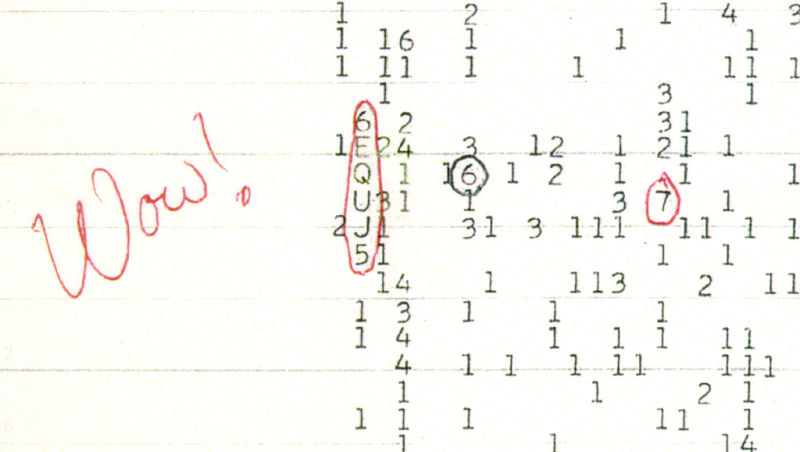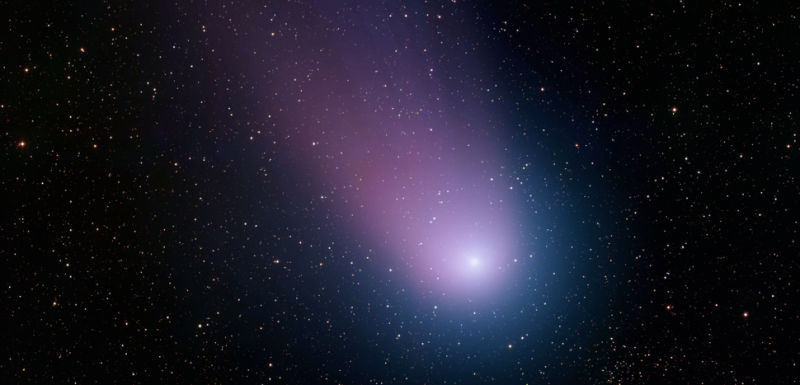
In 1977, astronomer Jerry R. Ehman observed a data signal so unique he drew a red circle around it and wrote “Wow!” to emphasize the discovery. The source of the signal was never identified, leading some to say it was aliens. But a new study suggests it wasn’t aliens at all—but rather a hydrogen cloud caused by comets.
The Wow! signal, as it’s known, was detected by Ehman while he was working on a SETI project at Ohio State University’s now defunct Big Ear radio telescope. While scanning the skies for evidence of extraterrestrial radio messages, he focused on a portion of the radio spectrum that resembles hydrogen. On August 15, 1977, he documented an extraordinary 72-second sequence of unusual intensity. Intriguingly, the signal appeared to have emanated from a M55, a globular cluster located in the constellation Sagittarius.
Follow-up analyses ruled out satellite interference, or that the signal was reflected from the Earth’s surface. Naturally, some people insisted it was an extraterrestrial message, a claim that’s never been proven. (For what it’s worth, Ehman never believed it was caused by aliens.)
http://gizmodo.com/the-many-many-…

The Many, Many Times Astronomers Mistook Mundane Phenomena for Aliens
The Many, Many Times Astronomers Mistook Mundane Phenomena for Aliens
The Many, Many Times Astronomers Mistook Mundane P
The science world is all in a tizzy this week about the supposed discovery of an alien…
Read more Read more
The only thing scientists have been able to agree on is that the signal definitely came from space. But from where? It’s a mystery that has lasted nearly 40 years. New Scientist reports the latest theory is that the signal may have been produced by comets.
Sponsored
According to Antonio Paris, an astronomer at St. Petersburg College in Florida, the Wow! signal could have been produced by one or two passing comets, namely 266P/Christensen and P/2008 Y2 (Gibbs). It sounds weird, but Paris says that comets are known to release considerable amounts of hydrogen when passing near the Sun. As they make their way into the inner Solar System, ultraviolet rays disturb the comet surface, releasing a cloud of hydrogen that extends like a tail for millions of miles. It could have been this cloud of hydrogen, says Paris, that caused the Wow! signal.

Some comets have gas. (Credit: NASA)
More from New Scientist:
If the comets were passing in front of the Big Ear in 1977, they would have generated an apparently short-lived signal, as the telescope (now dismantled) had a fixed field of view. Searching that same area – as subsequent radio telescopes did – wouldn’t show anything. Tracing the comets’ positions back in time, Paris says that the possible origin for the Wow! signal falls right between where they would have been.
Neither comet was known in 1977; they were both discovered in the last decade, which would mean nobody would have thought to search for them. The odds of any telescope catching them in the region of the Wow! signal by chance were vanishingly small.
But some astronomers aren’t buying it, arguing that one or two comets couldn’t possibly release enough hydrogen to produce such a strong signal. Thankfully, however, Paris has produced a testable hypothesis: Comet 266P/Christensen is coming back to our neighborhood in January 27, and P/2008 Y2 (Gibbs) will return in January 2018. By analyzing the comets’ hydrogen signatures, we should have a good idea if Paris’s theory is correct.
“The hypothesis must be tested before it is ruled out,” noted Paris in the New Scientist article. “Science 101.”
Read the entire study at the Center for Planetary Science: “Hydrogen Clouds from Comets 266/P Christensen and P/2008 Y2 (Gibbs) are Candidates for the Source of the 1977 “WOW” Signal”.
Email the author at george@gizmodo.com and follow him at @dvorsky.
Top image by the Ohio State University Radio Observatory and the North American AstroPhysical Observatory (NAAPO).
